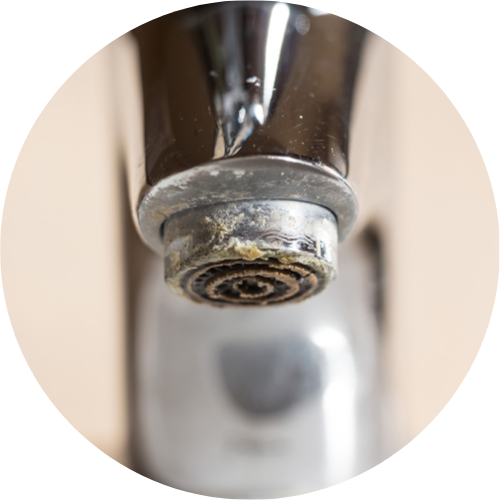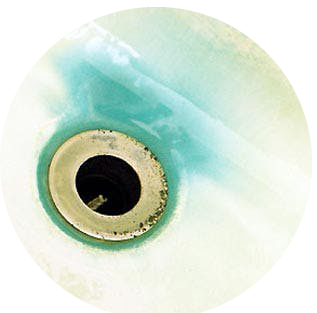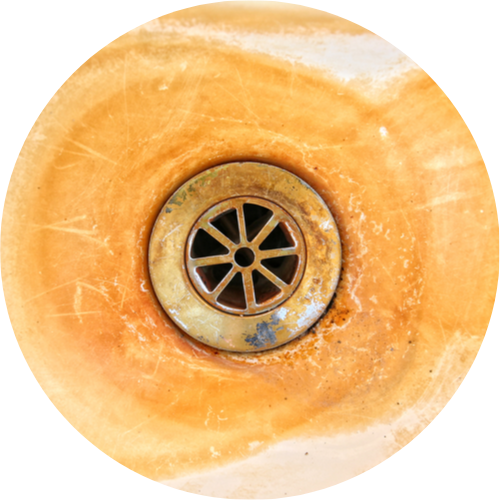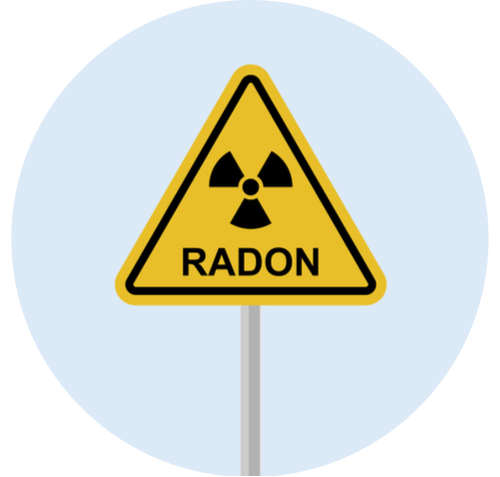Common Problems
Hard Water Problems
Water is the universal solvent. This means it absorbs a little of almost everything it makes contact with. Unfortunately, this results in several issues that can be detrimental to your home. Bathing with soap in hard water leaves a film of sticky soap curd on the skin. The film may prevent removal of soil and bacteria. Soap curd interferes with the return of skin to it’s normal, slightly acid condition, and may lead to irritation. Soap curd on hair may make it dull, lifeless and difficult to manage. Clothes washed in hard water often look dingy and feel harsh and scratchy. The hardness minerals combine with some soils to form insoluble salts, making them difficult to remove. When washing dishes, especially in a dishwasher, hard water may cause spotting and filming on your crockery. The minerals from hard water are released faster when it comes into contact with heat. Hard water also contributes to inefficient and costly operation of water-using appliances. Heated hard water forms a scale of calcium and magnesium minerals (limescale deposits) that can contribute to the inefficient operation or failure of water-using appliances. Pipes can become clogged with scale that reduces water flow and ultimately requires pipe replacement. Limescale has been known to increase energy bills by up to 25%.
Hard water is caused by groundwater dissolving and carrying away minerals, most often calcium, magnesium and iron, from rock. The majority of homeowners have hard water— including those on municipal water supplies—but most homeowners don’t know they have it and don’t realize the constant and expensive harm it causes.
When hard water comes in contact with heating elements or hot surfaces, it forms “scale” that builds up and shortens the life of water-using appliances like your water heater. Hard water also leaves deposits on your plumbing fixtures, tubs, sinks, dishes, silverware and glassware that are virtually impossible to clean. With hard water, soaps and detergents aren’t rinsed completely away, leaving a soap residue in your tub and shower (bathtub ring), on your laundry and even on you.
Do you struggle with any of the following?
- Your dishes have water spots on them.
- You always have dry, itchy skin and dried out hair.
- Your soap won’t lather well.
- Your white clothes look dingy.
- There’s white, crusty sediment on your fixtures.
- You see a recurring bathtub ring in your shower.
- You have rust-colored stains on your clothes, silverware, or porcelain fixtures.
If you said yes to any of the above, then you need to get your water tested for hard water.
Discuss your problem with one of our water consultants.
Bad Taste & Odor
In its pristine state, water is colorless, tasteless and odorless. So, if your water tastes or smells funny, you owe it to yourself to find out why.
Earthy or musty taste and odor: These types of complaints are generally the result of compounds released due to decayed vegetation and are typically associated with different forms of algae. While not toxic, they are nonetheless unpleasant and can be offensive at very low concentrations.
“Rotten egg” smell: Another common source of smelly water is hydrogen sulfide. Hydrogen sulfide is a colorless corrosive gas which has the characteristic odor of rotten eggs. If present in high enough concentrations, it can leave an unpleasant odor on hair and clothing. It can also accelerate corrosion of metal parts in appliances. The incidence of “rotten egg” sulfur odors and often the resulting black water in hot and cold water lines is due to the reaction of sulfated and microorganisms in water. Some well waters contain an excessive amount of sulfates with various strains of sulfate bacteria. These bacteria, harmless to health, will react in stagnant water that has been depleted of oxygen, and will produce hydrogen sulfide gas.
Metallic taste: As the name implies, a metallic taste to your water indicates the presence of metals such as iron, copper, manganese or zinc. Iron and manganese are often naturally occurring and are predominately found in groundwater. Copper and zinc can come from an aging water distribution system or the corrosion of copper plumbing and brass fittings.
Chlorine
Since the 1850s, chlorine has been used as a disinfectant to kill harmful bacteria in water itself or the pipes that transport it. Although It has helped end a number of major threats to public health and is essential at the treatment plant and in the water distribution system, it is no longer necessary once the water reaches your home.
Though chlorine is vital for stopping the spread of disease, its benefits come at a price. Chlorine tastes and smells bad. It dries skin and hair, fades clothes (bleach is made of chlorine), and can dry out the rubber seals in appliances, shortening their lives.
A-Plus Water Solutions will help you resolve your chlorine taste and smell problems throughout Southern GA and Northern FL.
Low pH
Low pH or “acid water’ can mean big problems for your plumbing, pipes and fixtures. The corrosive action of this type of water in your pipes is evident by the telltale bluish-green stains on your sinks or tubs (rust colored stains if you have galvanized iron pipes). These stains are evidence that your water is slowly dissolving your pipes and fixtures.
If this condition is allowed to continue over time, leaks in your plumbing system could develop. If the condition persists over extended periods of time, the pipes will become so thin that they may all have to be replaced.
Bacteria and Viruses
According to the Centers for Disease Control and Prevention, there could be as many as 12 million cases of waterborne acute gastrointestinal illness annually in the United States alone. These illnesses are frequently caused by bacteria, viruses and protozoa that make their way into the water supply. Even well operated, state-of-the-art treatment plants cannot ensure that drinking water is entirely free of microbial pathogens.
Iron Stains
Water is a natural solvent and given the needed time and conditions, it will dissolve anything it comes in contact with. That’s why, depending on where you live, your water can contain iron or manganese which can cause rusty-orange or black staining. You’ll see the stains on clothes, fixtures, sinks, tubs, water-using appliances and toilets. The telltale rust and black colored stains on sinks, toilets and showers, strong metallic taste and impossible to have clean laundry are clear signs that you have iron or manganese in your household’s water. Iron and manganese often occur in water together and are sometimes accompanied by their very unwelcome friend, the rotten egg of the water world: hydrogen sulfide gas. Iron in water typically takes on, three basic forms: ferrous iron, ferric iron and iron bacteria.
Radon
Radon is a naturally occurring radioactive gas. It’s produced when uranium, thorium, and radium break down in soil, rock, and water. It’s then released into the water. Radon is odorless, tasteless, and invisible. The primary routes of potential human exposure to radon are inhalation and ingestion.
Most scientists agree that the risk of death for radon at 4 pCi/L is approximately 1 in 100. At the 4 pCi/L EPA radon action guideline level, carries approximately 1000 times the risk of death as any other EPA carcinogen. The EPA has proposed to require community water suppliers to provide water with radon levels no higher than 0.4 pCi/L of radon in your home. It is important to note that the action level is not a safe level, as there are no “safe” levels of radon gas.
A-Plus’s Radon Removal System is manufactured for the removal of Radon and other VOC’s from residential water supplies. The system is a diffused bubble aeration system specifically designed for point of entry Radon removal from residential well water.
The system uses a process that introduces the contaminated water into the base of a series of chambers. High pressure filtered air is then blown through special diffusers that equally distributes the air in each of the treatment chambers. This process separates the radon from the water. The clean water awaits repressurization in a built-in quiescent tank. The gases released from this process are vented safely to the air outside your home through a 2″ vent pipe.
The system comes complete with UL listed control panel, and a Grundfos 1hp jet pump for water repressurization.
Arsenic
Arsenic is naturally present at high levels in the groundwater of a number of countries, and is highly toxic in its inorganic form.
Contaminated water used for drinking, food preparation and irrigation of food crops poses the greatest threat to public health from arsenic. Long-term exposure to arsenic from drinking-water can cause cancer. It has also been associated with cardiovascular disease and diabetes. In utero and early childhood exposure has been linked to negative impacts on cognitive development and increased deaths in young adults.
The most important action in affected communities is the prevention of further exposure to arsenic by provision of a safe water supply.
Nitrate
PFAS
- They’re all man-made.
- They contain linked chains of carbon and fluorine.
What is the effect of PFAS chemicals on health? And how do we know?
Because these chemicals have been used in many consumer products for many decades, most people have been exposed to them. People are exposed through highly contaminated drinking water, according to Laurel Schaider, a research scientist with the Silent Spring Institute. Studies estimate that 98% of Americans have detectable levels of PFAS in their blood.
Scientific studies have provided “strong evidence” linking PFAS exposure to elevated cholesterol, thyroid disease, damage to the liver and kidneys, effects on fertility and low birth weight, according to Schaider. Research also suggests that exposure to PFAS chemicals might suppress the immune systems of young children, potentially making vaccines less effective.
Some studies also suggest an elevated risk of testicular and kidney cancer in people exposed to higher levels of PFAS. Scientists are less certain about the health effects of newer PFAS compounds that replaced PFOS and PFOA, and the effects of low level exposure, Schaider says.
Despite the remaining uncertainty, scientists have found that PFAS chemicals affect “every major organ in the human body,” says Elsie Sunderland, a PFAS researcher at the Harvard T.H. Chan School of Public Health. “So that is scary for me.”










